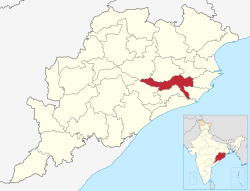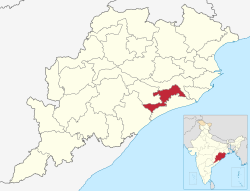
1. Cuttack (Katak)
The word “Katak” etymologically means army cantonment. The city of Cuttack started as a military cantonment because of its impregnable situation that further developed into the capital of the state of Odisha.

The word “Katak” etymologically means army cantonment. The city of Cuttack started as a military cantonment because of its impregnable situation that further developed into the capital of the state of Odisha.


2. Jagatsinghpur
It was known as Hariharpur till 1786. In 1748, The Maratha administration kept the place under their jurisdiction and appointed Jagat Singh to collect revenue. He collected the peshkush and Nazrana and remained an unchallenged and uninterrupted administrator +

It was known as Hariharpur till 1786. In 1748, The Maratha administration kept the place under their jurisdiction and appointed Jagat Singh to collect revenue. He collected the peshkush and Nazrana and remained an unchallenged and uninterrupted administrator +


for a pretty long period. The place was converted from Hariharpur to Jagatsinghpur after the name of Jagat Singh since 1786.
3. Kendrapara
Acc. to one theory, 'Tulasikshetra Mahatmya' by Sri Bipra Madhuri, BaladevaJew killed the demon king Kandarasura, who ruled over the region of Lalitgiri & married his daughter Tulasi. The place where the tyrant ruler Kandara was killed is named as Kendrapara +

Acc. to one theory, 'Tulasikshetra Mahatmya' by Sri Bipra Madhuri, BaladevaJew killed the demon king Kandarasura, who ruled over the region of Lalitgiri & married his daughter Tulasi. The place where the tyrant ruler Kandara was killed is named as Kendrapara +


Another theory says that 'Kendra' came from 'Kendara' (a musical instrument played by 'Natha Yogis' of this area and Para means a particular area / village.
4. Jajpur
Some scholars attribute it to Yajnapura (after the Dasaswamedha Yajna performed here by King Jajati), while others opine that the name originated from Jajatipura Sasanas in Jajpur area. Jajati is also said to have made Jajatipur as his capital and renamed as Jajapura.

Some scholars attribute it to Yajnapura (after the Dasaswamedha Yajna performed here by King Jajati), while others opine that the name originated from Jajatipura Sasanas in Jajpur area. Jajati is also said to have made Jajatipur as his capital and renamed as Jajapura.


5. Puri
Puri has been derived from word ‘Pur’ or ‘पुर’. Increasing order to refer a settlment as per their size in Sanskrit texts are gram (ग्राम) or village < pur(पुर) or town<nagar (नगर) or city<mahanagar (महानगर) or metropolis.

Puri has been derived from word ‘Pur’ or ‘पुर’. Increasing order to refer a settlment as per their size in Sanskrit texts are gram (ग्राम) or village < pur(पुर) or town<nagar (नगर) or city<mahanagar (महानगर) or metropolis.


6. Khordha
Khordha (Khurda) is derived from two Odia words- “Khura” and “Dhara”, meaning razor and edge, probably because the soldiers of Khurda were as sharp and dreadful as the edge of a razor.
Khordha Fort is referred as the “last independent fort”

Khordha (Khurda) is derived from two Odia words- “Khura” and “Dhara”, meaning razor and edge, probably because the soldiers of Khurda were as sharp and dreadful as the edge of a razor.
Khordha Fort is referred as the “last independent fort”


7. Nayagarh
It is believed that Suryamani of Baghela dynasty had come to Puri for pilgrimage from Rewa (M.P.). He built his fort in the jungles of present day Nayagarh. The New Fort (Naya Garh) gives the name to the place and district. +
It is believed that Suryamani of Baghela dynasty had come to Puri for pilgrimage from Rewa (M.P.). He built his fort in the jungles of present day Nayagarh. The New Fort (Naya Garh) gives the name to the place and district. +

Suryamani's successor Baghel Singh shifted his capital from Rewa to Nayagarh between 1480 - 1510.
8. Balasore (Baleswar)
Baleshwar is said to have got its name through the regional derivation of the word Baneswar, from Lord Baneshwar (Lord Shiva), the presiding deity of the town.

Baleshwar is said to have got its name through the regional derivation of the word Baneswar, from Lord Baneshwar (Lord Shiva), the presiding deity of the town.


10. Mayurbhanj
The name of the district is a portmanteau of Mayura (meaning peacock in Odia) and Bhanja, the name of the ruling dynasty of the district till 1949. It is believed that the Mayura was the name of another dynasty that merged with the Bhanjas +

The name of the district is a portmanteau of Mayura (meaning peacock in Odia) and Bhanja, the name of the ruling dynasty of the district till 1949. It is believed that the Mayura was the name of another dynasty that merged with the Bhanjas +


sometime around the 14th century. The peacock motif was later adopted by the Bhanjas and featured on the Mayurbhanj coat of arms.
11. Sambalpur Sambalpur derives its name from the Goddess Samalei (Odia: ସମଲେଇ ମାଁ), who is regarded as the reigning deity of the region 



12. Bargarh
The original name of the Bargarh District was “Baghar Kota” as known from an inscription of the 11th Century A.D. It was called “Bargarh” probably from the time of Balaram Dev, the Chauhan Raja of Sambalpur, +

The original name of the Bargarh District was “Baghar Kota” as known from an inscription of the 11th Century A.D. It was called “Bargarh” probably from the time of Balaram Dev, the Chauhan Raja of Sambalpur, +


13. Debagarh (Deogarh)
The first ruler of the Bamra state Saraju Gangadeb and Debagarh was it's capital - adobe of the Deba

The first ruler of the Bamra state Saraju Gangadeb and Debagarh was it's capital - adobe of the Deba


14. Balangir
Balaram Deo, the 19th Raja of Patna (princely state), founded a town called Balramgarh and shifted the capital of Patna state from Patnagarh to Balramgarh in the early 16th century. Subsequently the town was renamed as Balangir from Balramgarh.

Balaram Deo, the 19th Raja of Patna (princely state), founded a town called Balramgarh and shifted the capital of Patna state from Patnagarh to Balramgarh in the early 16th century. Subsequently the town was renamed as Balangir from Balramgarh.


15 - Subarnapur (Sonepur)
Once upon a time, this region was known as Paschima Lanka & Goddess Lankeswari was the presiding deity of Paschim Lanka. Subarnapur/Sonepur may refer to City of Gold,may be a reference to Goddess Lankeswari & the reference to the Golden City of Lanka

Once upon a time, this region was known as Paschima Lanka & Goddess Lankeswari was the presiding deity of Paschim Lanka. Subarnapur/Sonepur may refer to City of Gold,may be a reference to Goddess Lankeswari & the reference to the Golden City of Lanka


• • •
Missing some Tweet in this thread? You can try to
force a refresh













